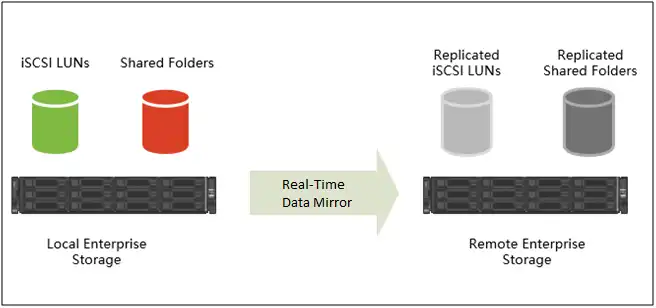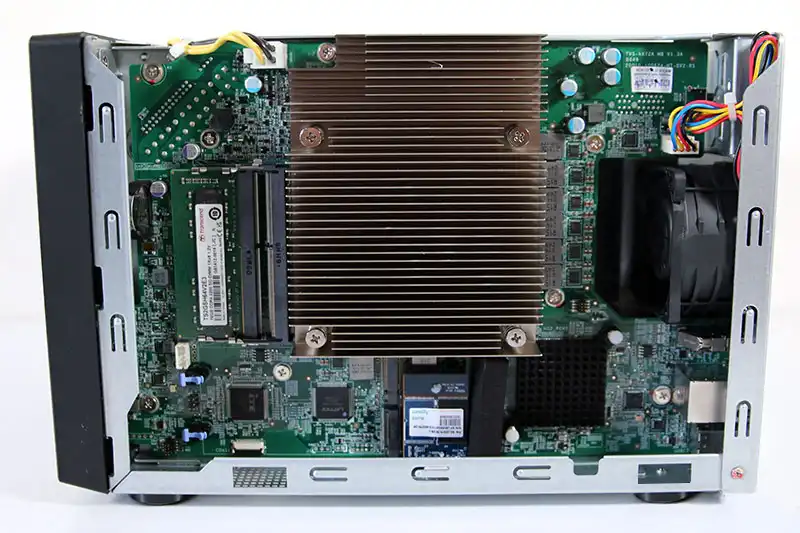You can also be interested in these:
- ZFS vs EXT4 vs BTRFS: What is the best file system for NAS
- WD My Book Live breach is causing data wipes worldwide
- Devolo WiFi 6 3000 and 5400 repeater full review
- Acer Predator Connect X5 full review
The QNAP TVS-h674 that we reviewed today is part of the new NAS family offered by QNAP to its users and businesses, providing them with state-of-the-art hardware to surpass their competitors. This unit comes equipped with an Intel i3-12100 or i5-12400 processor along with 16 or 32 GB of DDR4 memory, as well as 6 SATA bays, 2 NVME PCIe Gen4x4, and a PCIe expansion slot. This is a suitable environment for demanding tasks such as virtualization, AI applications, real-time SnapSync, and unlimited instant backups with the reliability of QuTS Hero and ZFS file system.

Exterior design
The QNAP TVS-h674 follows the same design guidelines as previous TVS models, in fact, it has the same dimensions as the QNAP TVS-672X that we reviewed at the time. Its tower format provides more placement options for a NAS with server-level or PC performance, allowing it to be placed under a desk or inside a piece of furniture without problems.
It is built on a robust metal chassis that integrates the rear and base area, and a metal cover is placed over the sides and top. The front uses a plastic cover that integrates the status panel for the storage bays on top, as well as the system notification LCD screen. We can interact with it through the button next to it.
We continue in this area to find 6 lockable, removable bays compatible with 3.5″ SATA HDDs and 2.5″ SSD/HDDs. To remove them, we will have to push the front lever outwards, finding a quick installation system for screwless HDDs. 2.5″ units do require fixation with three screws. Finally, in the lower right corner, we find the power button, just above the USB 3.2 Gen2 Type-C port and a quick copy button.
The sides are completely smooth, with corresponding grills for air intake in both the hard disk and motherboard areas. The top has nothing to mention.

Four wide legs with anti-vibration rubber protection have been placed on the bottom, which honestly, reduce the noise of mechanical hard drives little. There is an additional grill to cool the hard drive area, but both lack a dust filter.
Ports and connectivity
We move to the back to see the arrangement of the QNAP TVS-h674 interfaces, which are fewer than in the 672X model. We have three fans, two 80mm and one smaller for the motherboard area. Next to the PCIe expansion slots, there is a power supply with its corresponding 3-pin generic input and fan.
The port panel consists of:
- PCIe 4.0 x16 slot (CPU)
- PCIe 4.0 x4 slot (CPU)
- Reset button
- 1x HDMI 1.4b 4096 x 2160 @30 Hz
- 2x RJ45 2.5 Gbps
- 1x USB 3.2 Gen2 Type-C
- 1x USB 3.2 Gen2 Type-A
- Kensington lock slot
Expansion slots experience significant improvement moving from 3.0 to 4.0 thanks to Intel processor’s native capability and increase slot width adopting typical PC tower format. This means compatibility with expansion cards increases significantly.
The dedicated HDMI video interface is maintained, though surprisingly becomes 1.4 instead of 2.0, limiting the resolution to 4K30 Hz. It supports real-time video transcoding and is a perfect NAS for multimedia tasks like PLEX server, media center, or surveillance and supports in-situ management with mouse and keyboard through USB interfaces. It offers variety with 10 Gbps Type-A and Type-C connections.
Network connectivity is insufficient compared to our expectations, as we have two 2.5 Gbps interfaces that will support link aggregation to increase capacity to 5 Gbps. We believe that 10 Gbps ports would have been ideal to take advantage of the great speed offered by NVMe SSDs.
Interior and Hardware
To access the interior of the QNAP TVS-h674, we must remove three screws that hold the board in the back. This process does not void the warranty, as it is necessary to access to install an expansion card or NVMe SSD.
The motherboard is vertically placed on the right side and should improve with each generation to accommodate more powerful CPUs. That’s why we have a VRM composed of 5 + 1 power phases, using Monolithic Power Systems MPSN40 MOSFETS and chokes with metallic encapsulation beads. The chipset will have a small aluminum passive heatsink.

This is the least powerful version, if you will, that comes with an Intel Core i3-12100 processor. This processor can be purchased for our own equipment as it is not a T variant. Based on the 10 nm Alder Lake architecture, it has 4 performance cores and 8 threads at 4.3 GHz, with a 12 MB L3 cache and 60W base TDP (PL1).
As for integrated graphics (iGPU), we have the Intel UHD Graphics 730, composed of 24 execution units at 1.4 GHz. It is accompanied by a 16 GB DDR4 RAM module at 3200 MHz, supporting up to 64 GB with its two SODIMM slots.
This processor in a NAS is very powerful and has the capacity to perform high-demand tasks. QNAP still relies on a passive aluminum heatsink, enhanced with a cold plate and copper heat pipes, but it’s time to consider a more powerful one to avoid falling short. The more powerful version is the Intel Core i5-12400 with 6C/12T and comes with 32 GB of SODIMM DDR4 RAM installed as standard. The rest of the features remain the same.

On the motherboard, we find two Gen4x4 M.2 slots, which have been significantly improved compared to the Coffee Lake based models. Now, they can reach a data transfer speed of 8000 MB/s. This NAS is the first family to support Gen4 SSD, giving it a great advantage in massive file transfers, system agility and data cache. Additionally, with its 6 SATA bays, the NAS is compatible with file formats such as EXT3, EXT4, NTFS, FAT32, HFS+, exFAT and most importantly, ZFS thanks to its compatibility with QuTS Hero. It also supports storage configurations such as JBOD and Single, as well as RAID 0, 1, 5, 6, 10, 50, and 60.
Operating system
This QNAP TVS-h674 NAS can run on QTS 5.0.0 or higher, and with QuTS Hero, which is highly recommended due to its advanced options, such as the ZFS file system with block writing, data deduplication, advanced compression and unlimited snapshot capability.
At the front of the device, we find an interesting status screen, following the dynamic of the other TVS models. This small LCD panel shows us the startup process of the NAS’s services and interfaces, and then provides us with information about the TCP/IP interfaces, disk capacity and temperature, storage volumes, and hardware and fan details. This surpasses the simple LED indicators for hard drives, LAN and system.
To access this NAS, we have installed QuTS Hero, the most downloadable version. First, we will log in with the “admin” user and the password of the uppercase MAC1 address without hyphens. Then, the system will guide us through the configuration of volumes and storage spaces so that we can start using the NAS.
One of the most notable uses of the QNAP TVS-h674 will be as a business storage, with an Intel AES-NI 256 hardware accelerated encryption engine to protect confidential data. The integrity, deduplication and secure writing provided by the ZFS system will be essential to take advantage of its large capacity. ZFS supports multi-level cache with power failure protection, RAID Z and QSAL to prevent SSD failures.
With a PC-level CPU, its best application is working with multimedia content, either as a storage or a server with network media such as DLNA or servers like PLEX and KODI. It also supports real-time video transcoding and image recognition with AI thanks to Google Edge TPU, QNAP AI Core, and Intel OpenVINO technology. It can also be used as a surveillance station with QVR.
Another application that has been powered by these CPUs is virtualization, both through applications and Docker, as well as hardware virtualization with VMware ESXi or Microsoft Hyper-V. The impressive frequency in these 64-bit CPUs provides great performance and fluidity through the graphical interface, while also offering the excellent security and robustness of the Linux kernel for administrators.
Final words and conclusion about the QNAP TVS-h674
In terms of conclusions about the QNAP TVS-h674, this device gives a twist to its enterprise-level NAS series thanks to its impressive multitasking performance using Intel Alder Lake processors, which could be used in a personal computer. Furthermore, it drastically improves multitasking capacity, something increasingly important in the multimedia and data server world.
The Intel platform also improves the NAS expansion connectivity with M.2 PCIe Gen4x4 slots and redesigned PCIe 4.0 slots to support larger cards. However, there are two aspects that are missing, such as more powerful network interfaces with only 2x 2.5 Gbps and an HDMI 2.0 port instead of 1.4. The QuTS Hero operating system will be the most complete and secure to get the best out of this NAS.
The price of the QNAP TVS-h674 with i3 and 16 GB will be around $2,500 USD, while the i5 model with 32 GB goes up to $2,950 USD in the 6-bay towers. Although it is a high price, it is affordable for users in highly demanding environments, being much more advanced than a rival like the Synology DS1621+. At the moment, it has no rival, those who invest in it will practically take the best on the NAS market.
More stories like this
- ZFS vs EXT4 vs BTRFS: What is the best file system for NAS
- WD My Book Live breach is causing data wipes worldwide
- Devolo WiFi 6 3000 and 5400 repeater full review
- Acer Predator Connect X5 full review
- Asus CMAX6000 router review
- Amazon Prime Video: All about this streaming service